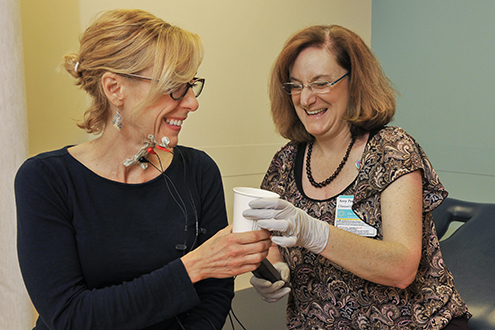Speech, Language and Swallowing Disorders
Brown University Health offers several outpatient rehabilitation options for patients with speech, language and swallowing disorders:
Difficulties with swallowing and feeding may stem from a number of conditions. A modified barium swallow study – an x-ray of the swallow – may be done in conjunction with the radiology department to further evaluate function.
Myofascial Release for Swallowing
A clinician uses myofascial release to manually free the muscles involved with swallowing to improve function. Before initiating treatment, an expert speech-language pathologist will assess your current swallowing skills.
Stuttering (dysfluency) is a speech disorder characterized by interruptions in the flow of speech. All people experience dysfluent speech, but for people who stutter, the interruptions occur more often in and in a different way. People who stutter may have more negative feelings about their speaking pattern and may feel self-conscious or lack confidence in their ability to speak in a variety of situations.
Facts about Stuttering
Approximately 1 percent of the population stutters, and males are more likely to stutter than females. Many famous people have stuttered or continue to, including James Earl Jones, John Stossel, Marilyn Monroe, Carly Simon, Darren Sproles, and Marc Anthony.
The precise cause of stuttering isn’t known, but most experts agree that it can be based in the brain (neurological) or run in families (genetic). Also, stuttering may increase based on environmental stressors (starting a new school, moving to a new house), emotions (nervousness, excitement, anger) or language demands (having to answer a question quickly or speaking in front of people). Stuttering usually starts between ages 2 and 5, when speech and language skills are developing. Stuttering may resolve on its own or may persist, requiring speech-language intervention.
Treatment for Stuttering
Brown University Health’s speech-language pathologists are trained in the evaluation, diagnosis and treatment of fluency disorders experienced at life stages from toddler to adult.
The type of intervention depends on the patient’s age and communication skills, and is tailored to their individual needs. Therapy may include the following techniques:
- fluency shaping
- stuttering modification
- parent-child interaction
- cognitive-behavioral
Everyone has experienced difficulty with their voice at one time or another. Often signaled by symptoms such as hoarseness, loss of voice, reduced volume, breathy quality or excessively nasal speech, voice and resonance disorders can affect people of any age or occupation.
Speech-language pathologists utilize state-of-the-art technology to diagnose and treat voice and resonance disorders. Our expert speech-language pathologists work closely with the otolaryngology and plastic surgery departments to provide comprehensive patient care.
Conditions We Treat
Therapy treats these diagnoses:
- Vocal fold nodules, polyps, cysts, and paralysis
- Paradoxical vocal fold movement
- Spasmodic dysphonia
- Velopharyngeal insufficiency/incompetence
- Head and neck cancer
- Parkinson’s disease
- Ceft palate/lip/submucous cleft
Evaluations may include:
- Clinical/perceptual evaluations that assess vocal parameters including pitch, vocal quality/clarity, loudness, resonance
- Videostroboscopy to visualize the vocal folds and assess structure and function
- Videonasopharyngoscopy to observe the soft palate during speech to assess structure and function
- Multiview speech videofluoroscopy to observe the soft palate closure pattern through a “motion X-ray”
Treatment Options for Voice Resonance Disorders
These intervention techniques may be applied:
- Vocal hygiene education
- resonant voice program
- direct individualized speech therapy for resonance disorders
- vocal function exercises
- Lee Silverman Voice Treatment (LSVT LOUD)
Lee Silverman Voice Treatment (LSVT LOUD)
LSVT LOUD is a speech treatment for individuals with Parkinson’s disease and other neurological conditions. Devised in 1985, Lee Silverman Voice Treatment was named for the first patient who underwent the therapy.
LSVT LOUD improves vocal volume by stimulating the muscles of the voice box (larynx) and speech mechanism through a systematic exercise program. Focused on a single goal – “speak LOUD!” – the treatment improves respiratory, laryngeal and articulatory function to maximize speech intelligibility.
Learn more about outpatient rehabilitation services at Brown University Health »
Our speech-language pathology department provides all types of therapy to adults and children whose native language is not English. Recommendations for therapy, classroom accommodations, additional services and consultations are provided.
Our bilingual speech-language pathologist provides services to Spanish- or Portuguese-speaking adults and children who display communication delays/disorders. The therapist understands both cultural and language differences and the process of normal speech and language acquisition for both bilingual and monolingual individuals.
Rhode Island Hospital or community-based interpreters meet patient needs for comprehensive assessments/intervention.
About Referrals for Bilingual Speech and Language Services
When to refer for a bilingual (Spanish-English/Portuguese-English) speech and language evaluation at Rhode Island Hospital/Hasbro Children’s:
- language classification on language proficiency tests indicate dominance in Spanish or Portuguese
- language proficiency is questioned
- the individual responds in Spanish or Portuguese when spoken to by family members
- informal communication with adults and peers indicates that the individual can understand Spanish or Portuguese, but responds in either Spanish/Portuguese or English
Interpreters, including those fluent in American Sign Language, are available to assist non-English speaking patients as well as patients who are hearing impaired. Rhode Island Hospital provides a staff of trained interpreters who are native speakers of many languages, including Cambodian (Khmer), Laotian, Thai and Russian. Assistance with other languages is available upon request through community agencies.

- Outpatient Rehabilitation at the Vanderbilt Rehabilitation Center
- Outpatient Rehabilitation at Morton Hospital
- Outpatient Rehabilitation Treatment Methods
- Conditions We Treat
- Specialty Programs
- Outpatient Rehabilitation Team
- Outpatient Rehabilitation Frequently Asked Questions
- Physical Therapy Helps Surfer Get Back on the Board
